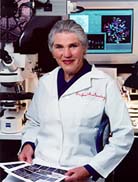
Janet Davison Rowley (April 5, 1925 - ) is an American human geneticist and the first scientist to identify a chromosomal translocation as the cause of leukemia and other cancers.
In 1940, aged 15, she was granted a scholarship to study in an advanced placement program at the University of Chicago Laboratory Schools where she finished high school and the first two years of college, followed by completion of her degree at the University of Chicago, where she earned a Bachelor of Philosophy degree in 1944, a bachelor of science degree in 1946, and doctor of medicine degree in 1948, aged 23.
In 1955 she took up a research post at Chicago's Dr. Julian Levinson Foundation, a clinic for children with developmental disabilities, where she remained until 1961. She also taught neurology at the University of Illinois School of Medicine.
In the 1970s, she further developed the use of existing methods of quinacrine fluorescence and Giemsa staining to identify chromosomes, and demonstrated that the abnormal Philadelphia chromosome implicated in certain types of leukemia was involved in a translocation with chromosome 9 in some cases. Translocation is the process by which a piece of one chromosome breaks off and joins another chromosome, or when two chromosomes exchange material when both break. She also identified translocation between chromosomes 8 and 21 in acute myelogenous leukemia.
When Dr. Rowley published her findings in the 1970s, she argued that specific translocations caused specific diseases, going against the established view of the cause of cancer which gave little significance to chromosomal abnormalities.
In 1984, Dr. Rowley was made the Blum-Riese Distinguished Service Professor at the University of Chicago. In 1998, she was one of three scientists awarded the prestigious Lasker Award for their work on translocation, and received the National Medal of Science in 1999. In 2009, Dr. Rowley was awarded the Presidential Medal of Freedom and the Gruber Prize in Genetics. She has published more than four hundred articles and continues her research at the University of Chicago.